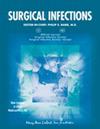Spectrum of Pathogens in Surgical Site Infections after Sarcoma Resection in the Peri-Pelvic and Pelvic Region. Distinct Location, Distinct Infection?
IF 1.4
4区 医学
Q4 INFECTIOUS DISEASES
引用次数: 0
Abstract
Background: Soft tissue sarcomas (STS) often occur in the peri-pelvic region (proximal thigh, groin, gluteal region). A common complication following resection of STS is surgical site infection (SSI). The peri-pelvic site appears to be particularly problematic. Surgical site infections are associated with a high proportion of gram-negative and anaerobic micro-organisms. To date, there are no published recommendations for peri-operative antibiotic prophylaxis in pelvic STS resection. Therefore, the aim of this study was to determine the rate of SSI and the spectrum of micro-organisms detected in this region. Methods: In this monocentric study, 366 patients were retrospectively evaluated. All of these patients had undergone surgery for STS in the peri-pelvic and pelvic regions. Surgical site infections were recorded, and the microbial spectrum was analyzed. Results: There were 85 (23.2%) patients with SSI, and 188 revisions were required in these patients (2.21 per case). Swabs were sterile in 20% of clinically infected cases. In total, 36.5% of infections were polymicrobial. The most common bacteria were coagulase-negative staphylococci in 31.5%, followed by Enterococcus species in 13.3% and Escherichia coli in 7.7%. In total, 30.8% of the bacteria were gram-negative and 25.9% were anaerobic. Conclusions: Our results demonstrate the uniqueness of the bacterial spectrum of SSI after STS resection in the peri-pelvic region. In the authors' opinion, recommendations regarding the peri-operative antibiotic prophylaxis need to be adapted for the typical microbial spectrum at this site.骨盆周围和骨盆区域肉瘤切除术后手术部位感染的病原体谱。不同的位置,不同的感染?
背景:软组织肉瘤(STS)通常发生在骨盆周围区域(大腿近端、腹股沟、臀部)。切除 STS 后常见的并发症是手术部位感染(SSI)。骨盆周围部位似乎尤其容易发生感染。手术部位感染与高比例的革兰氏阴性和厌氧微生物有关。迄今为止,还没有关于盆腔 STS 切除术围手术期抗生素预防的公开建议。因此,本研究旨在确定该区域的 SSI 感染率和微生物谱。方法:在这项单中心研究中,对 366 名患者进行了回顾性评估。所有这些患者都曾在骨盆周围和骨盆区域接受过 STS 手术。对手术部位感染进行了记录,并对微生物谱进行了分析。结果:有 85 例(23.2%)患者出现 SSI,这些患者需要进行 188 次翻修(每例 2.21 次)。临床感染病例中有 20% 的拭子是无菌的。共有 36.5% 的感染为多菌感染。最常见的细菌是凝固酶阴性葡萄球菌(31.5%),其次是肠球菌(13.3%)和大肠杆菌(7.7%)。总共有 30.8% 的细菌为革兰氏阴性,25.9% 为厌氧菌。结论我们的研究结果表明了骨盆周围地区 STS 切除术后 SSI 细菌谱的独特性。作者认为,有关围手术期抗生素预防的建议需要根据该部位的典型微生物谱进行调整。
本文章由计算机程序翻译,如有差异,请以英文原文为准。
求助全文
约1分钟内获得全文
求助全文
来源期刊

Surgical infections
INFECTIOUS DISEASES-SURGERY
CiteScore
3.80
自引率
5.00%
发文量
127
审稿时长
6-12 weeks
期刊介绍:
Surgical Infections provides comprehensive and authoritative information on the biology, prevention, and management of post-operative infections. Original articles cover the latest advancements, new therapeutic management strategies, and translational research that is being applied to improve clinical outcomes and successfully treat post-operative infections.
Surgical Infections coverage includes:
-Peritonitis and intra-abdominal infections-
Surgical site infections-
Pneumonia and other nosocomial infections-
Cellular and humoral immunity-
Biology of the host response-
Organ dysfunction syndromes-
Antibiotic use-
Resistant and opportunistic pathogens-
Epidemiology and prevention-
The operating room environment-
Diagnostic studies
 求助内容:
求助内容: 应助结果提醒方式:
应助结果提醒方式:


